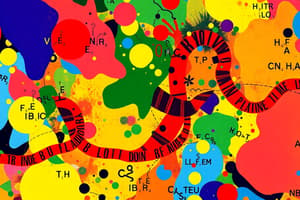Podcast
Questions and Answers
What type of bond connects the nitrogenous base to the monosaccharide in a nucleoside?
What type of bond connects the nitrogenous base to the monosaccharide in a nucleoside?
- Hydrogen bond
- N-Glycosidic bond (correct)
- Phosphodiester bond
- Ester bond
Which of the following substances is required for the synthesis of purine nucleotides de novo?
Which of the following substances is required for the synthesis of purine nucleotides de novo?
- 5-phosphoribosyl-1-diphosphate (PRPP) (correct)
- Ribonucleosides
- Cytosine
- Deoxyribose
What is the main site for purine nucleotide synthesis in the body?
What is the main site for purine nucleotide synthesis in the body?
- Liver (correct)
- Muscle cells
- Kidneys
- Heart
Which compound can inhibit the enzyme dihydrofolate reductase?
Which compound can inhibit the enzyme dihydrofolate reductase?
What type of bond is found between the phosphate group and the sugar in a nucleotide?
What type of bond is found between the phosphate group and the sugar in a nucleotide?
Which of the following purine nucleotides is NOT correctly classified?
Which of the following purine nucleotides is NOT correctly classified?
What type of feedback mechanism regulates nucleotide synthesis?
What type of feedback mechanism regulates nucleotide synthesis?
Which class of nucleotides contains thymine as a base?
Which class of nucleotides contains thymine as a base?
Flashcards
Purine nucleotide synthesis (de novo)
Purine nucleotide synthesis (de novo)
The creation of purine nucleotides from simpler molecules, requiring significant energy.
Purine Salvage pathway
Purine Salvage pathway
Recycling of purine bases/nucleosides to form nucleotides; less energy intensive than the de novo pathway.
Pyrimidine nucleotide synthesis (de novo)
Pyrimidine nucleotide synthesis (de novo)
The process of creating pyrimidine nucleotides from simpler molecules.
PRPP (5-phosphoribosyl-1-pyrophosphate)
PRPP (5-phosphoribosyl-1-pyrophosphate)
Signup and view all the flashcards
Feedback inhibition in nucleotide synthesis
Feedback inhibition in nucleotide synthesis
Signup and view all the flashcards
Nucleoside structure
Nucleoside structure
Signup and view all the flashcards
Nucleotide structure
Nucleotide structure
Signup and view all the flashcards
Folate activation
Folate activation
Signup and view all the flashcards
Study Notes
Metabolism of Purines and Pyrimidines
- Purines and pyrimidines are essential components of nucleotides, the building blocks of DNA and RNA.
- The metabolism of these molecules involves both synthesis (de novo) and recycling (salvage pathways).
Purine Bases
- Adenine, guanine, hypoxanthine, and xanthine are purine bases. These are represented by specific chemical structures.
- The structures show their nitrogen-containing ring systems.
Pyrimidine Bases
- Uracil, cytosine, and thymine are pyrimidine bases.
- These are also represented by their chemical structures, showing the nitrogen-containing ring systems.
Nucleotides
- Nucleotides are composed of a nitrogenous base (purine or pyrimidine), a five-carbon sugar (ribose or deoxyribose), and one or more phosphate groups.
- A β-N-glycosidic bond links the base to the sugar.
- Nucleotides are classified as ribonucleotides (ribose sugar) and deoxyribonucleosides (deoxyribose sugar).
Structure of Purine and Pyrimidine Nucleotides
- Nucleotide bases are aromatic heterocycles.
- Purines consist of a pyrimidine ring fused to an imidazole ring.
- Pyrimidines are single six-membered rings.
- Nucleosides are formed by linking a nitrogenous base to a pentose sugar via a β-N-glycosidic bond.
- Nucleotides are formed by connecting one or more phosphate groups to the sugar of a nucleoside.
Synthesis of Purine Nucleotides
- De novo synthesis involves building the purine rings from simpler molecules like amino acids.
- Salvage reactions synthesize purines from preformed bases or nucleosides.
- Salvage pathways require less energy than de novo synthesis and are often regulated by feedback mechanisms.
- Key substrates for purine nucleotide synthesis include purine bases (adenine, guanine, hypoxanthine), ribonucleosides, and PRPP.
- Important coenzymes include tetrahydrofolate and NAD+.
Synthesis of Purine Nucleotides (de novo)
- Synthesis occurs primarily in the cytoplasm of many cells, predominantly in the liver.
- Essential energy-consuming processes utilize ATP.
- Critical substrates include 5-phosphoribosyl-1-diphosphate (PRDP/PRPP), amino acids (aspartic acid, glutamine, glycine), and tetrahydrofolate derivates.
Synthesis of Pyrimidine Nucleotides
- De novo synthesis builds pyrimidine rings from simpler molecules like CO2, aspartate, and glutamine.
- Salvage reactions synthesize pyrimidine nucleotides from preformed bases or nucleosides.
- Key substrates include PRPP, carbamoyl phosphate, aspartate, and methylene-THF (for thymidine formation).
- Reactions occur primarily in the cytoplasm, with carbamoyl phosphate formation in mitochondria.
Regulation of Nucleotide Synthesis
- Feedback inhibition plays a crucial regulatory role.
- Key enzymes like PRPP synthetase and carbamoyl phosphate synthetase II are regulated by nucleotide concentrations.
- Specific inhibitors like methotrexate impact purine synthesis and are important in medical contexts.
Activation of Folate
- Dihydrofolate reductase converts folate to tetrahydrofolate using NADPH as a reducing agent. This reaction is critical for many biosynthetic pathways including nucleotide synthesis.
- Methotrexate is a significant inhibitor of this reaction, impacting many metabolic processes.
Studying That Suits You
Use AI to generate personalized quizzes and flashcards to suit your learning preferences.
Related Documents
Description
This quiz focuses on the metabolism of purines and pyrimidines, essential components of nucleotides crucial for DNA and RNA. It covers their synthesis, recycling, and structures of key bases including adenine, guanine, uracil, cytosine, and thymine. Test your knowledge on these fundamental biochemical processes.




